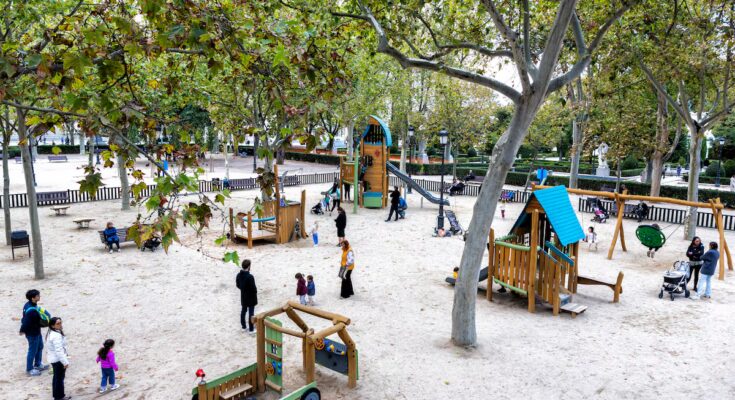Those who seek the paradise of Madrid’s playgrounds you will discover it just a few meters from the Royal Palace. There, hidden behind the plane trees of the Lepanto Gardens, there is the ideal setting where the little ones can have fun and let their imagination fly. The enclosure does not lack details: it is spacious, away from traffic and, in addition, it is equipped with a wide variety of games, rest areas, vegetation and good lighting. All these amenities have transformed the Lepanto Gardens park into the best play area in the capital, according to research by architect Carla Silva (Oviedo, 40 years old). The expert clarifies that this space is not the one that received the highest average score, but it was the one that was rated by the greatest number of people, 18 in total.
In the same study, in which 813 users voted through a form for the best and worst parks in the capital, Tirso de Molina was the one that received the most negative response from those interviewed, who reported problems of dirt, lack of maintenance and drug use in the area. The ranking of the best and worst areas for children that Silva sent to this newspaper is part of a larger investigation covering around 300 parks in the City of Madrid.
“The parks are worse than I thought,” Silva concludes after reviewing hundreds of responses. The x-ray of Madrid’s playgrounds shows the great imbalances that exist in the city in terms of cleanliness, maintenance and aesthetics, and reveals more serious conflicts: “I have come across many comments denouncing that there are problems with alcohol and drug consumption in the parks themselves. This makes the maintenance much worse. In Tirso de Molina almost all the criticism goes in that direction.”
She, a mother of two daughters, is one of the people affected by the damage suffered by these infrastructures and by the cracks in coexistence, aggravated by parks such as the one in Plaza de Tirso de Molina, currently under construction. “It is a place full of crime at any time of the day, in fact people who deal drugs or drunks settle in the park, which is why families don’t go there even if it is close to us. You almost never see children playing”, complains one of the interviewees. He’s not the only one. Another person who participated in Silva’s work adds that the place is “unfriendly to children.” Added to the problems of insecurity are dirt and, above all, the lack of vegetation, which is fundamental in an environment surrounded by concrete and asphalt, especially in summer when the heat is intense.
The expert, who graduated in Architecture from the University of A Coruña (UDC), began her research with a hypothesis on the lack of cleanliness in the capital’s play areas, but the results of her work offered her a much broader overview of the needs expressed by residents. “The investigation allowed me to confirm my hypotheses and take a further step forward. The idea was that all these complaints, which in some cases are very important, were known and did not remain in a drawer”, he explains. One of the complaints that surprised him the most is that of the users of the park on Antonio González Porras street. There, three interviewees noticed the presence of rats nearby, a very serious problem that earned it the second worst score of all the parks evaluated, just 1.33 out of 5.

In addition to the playgrounds of Tirso de Molina and Antonio González Porras, those of the streets Beneficencia, Corazón de María, Ministriles Chica, Sierra de Alquife and Paseo de Santa María de la Cabeza fail with scores no higher than 2 and thus complete the superior 7 of the worst play areas in Madrid. Among all these places there is a mountain of requests from citizens, ranging from the installation of games of various kinds, to the renovation of the flooring, the creation of rest areas or the improvement of waste management.
Luckily for the families, not everything in the investigations is negative. “There are many (parks) where good work has been done,” defends architect Carla Silva. For example, in addition to the children’s area of the Lepanto gardens, which received a total of 18 ratings with an average of 4.24 out of 5, the play areas of Avenida de Valladolid, Paseo de la Virgen del Puerto, Casa de Campo, Calle del Parroco Eusebio Cuenca, El Retiro, Calle de la Antracita, Plaza Villa de París and Calle del Gasómetro also stand out for their quality. condition.
One of the factors that explain the abandonment of some playgrounds, says Silva, is the low visibility of these spaces on the political agenda and in the media: “At this moment, when we govern our cities with data, there are highly represented issues, such as the problem of house prices or mobility, but there are others, such as the use of public space, for which no data exists, and for this reason they are relegated.”
Although the horizon is not very encouraging, the architect is confident that her research will contribute, within the limits of its possibilities, to arouse greater interest in the care and protection of spaces dedicated to children in the capital. “They are spaces that, with a little more care and giving them the importance they deserve, could bring benefits to many people,” he says with a glimmer of hope that the state of the parks will improve. Now the ball passes to the Municipality of Madrid.



